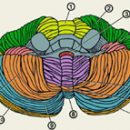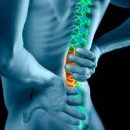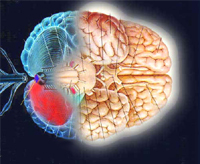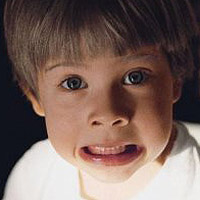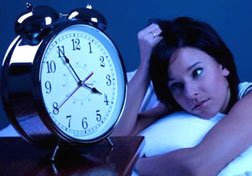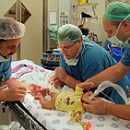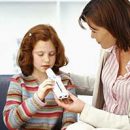Nervous diseases are dangerous to returning the lost mobility of the muscles no longer succeed, but in the case of Hyien-Barre syndrome, healing is possible and rehabilitational measures are played in this - massage, medicinal physicalation, mud.
Content
 In 1916. Guillana, Barre and Stretch described a special form of primary polyradiculoneuritis in 2 soldiers of the French army. The disease had a characteristic picture: parish limbs (exhausting motor function), the fuss of tendon reflexes, paresthesia (feeling of goosebumps by body), light sensitivity disorders and protein-cell dissociation in the spinal fluid (significant increase in protein content at normal cellular composition). Less than 2 months came recovery. Initially, the authors believed that the disease was subsequently called «Hyien Barre Syndrome» (The surname of the third author was unjustly excluded), has a favorable forecast. However, as it turned out later, with the syndrome, death is possible due to the development of ascending paralysis and respiratory failure.
In 1916. Guillana, Barre and Stretch described a special form of primary polyradiculoneuritis in 2 soldiers of the French army. The disease had a characteristic picture: parish limbs (exhausting motor function), the fuss of tendon reflexes, paresthesia (feeling of goosebumps by body), light sensitivity disorders and protein-cell dissociation in the spinal fluid (significant increase in protein content at normal cellular composition). Less than 2 months came recovery. Initially, the authors believed that the disease was subsequently called «Hyien Barre Syndrome» (The surname of the third author was unjustly excluded), has a favorable forecast. However, as it turned out later, with the syndrome, death is possible due to the development of ascending paralysis and respiratory failure. In this regard, the similarity of the Picture of Guillana Barre syndrome and suffering, which was watching Landry back in 1859. In 10 patients: ascending paralysis, including muscles of the face and language, with minor sensitivity disorders. Heavy symptoms quickly increased, 2 patients died. In the future, the disease was determined as «Ascending Palsy Landri». The conclusion was made that the diseases under consideration are different, mainly in terms of the severity of the current, the variants of the same process. Many authors offered to combine them under the general name: «Landry-Guien Barre Syndrome».
In the following years, two directions arose in the study of Hyien-Barre syndrome. One of them is characterized by a description of new symptoms and as a result of this by the denial of the independence of the disease, another, by contrast, is the release of Guienen-Barre syndrome from a large group of polyneuropathies in a separate form. According to modern ideas that are used by neuropathologists. Terms «Hyien Barre Syndrome», «Landri syndrome», «Landry-Guien-Barre-Stretch syndrome», «acute primary polyradiculoneuritis», «Acute inflammatory demyelinizing polyneuropathy», «Acute post-infectious polyneuropathy», essentially denote the same disease.
In the international classification of diseases x revision, this suffering is included entitled «Acute post-infectious polyneuropathy», or Guillana Barre Syndrome.
Guillana Barre syndrome is found in 1.7 cases per 100,000 population, equally often in different regions, at any age, men are more often than in women, and is about 20% of all polyneuropathies.
Physiotherapeutic procedures in the restorative period are aimed at reducing pains, vegetative disorders, acceleration of regenerative and reparative (restoration) processes in a neuromuscular apparatus, improved blood circulation, a decrease in edema and inflammatory phenomena, prevention of trophic disorders and muscle contractures (mobility limitation).
From the first days of disease to reduce pain, thermal procedures (solux), inductothermia. In the acute beginning of the infectious process, they are recommended only after improving the overall condition and normalization of body temperature. Effective impact of the magnetic field to the top, and then on the lower limbs, laser therapy for pain points along the nerves.
First apply passive, then active medicinal gymnastics, massage. In hospitals and clinics, exercises are recommended for restoring equilibrium, banking, parallel bars, three-stroke crutches, etc.
After the normalization of the temperature and termination of the paresis, the electrophoresis of prozerne, galanamine, potassium iodide, novocaine, along with a concentrating therapy, are prescribed. Useful 4-chamber baths. The electrophoresis method is developed for sinusoidal modulated currents. UHF electric field (ultra-frequency therapy). In the early reducing period, use the effects of the pulsed electric field UHF to the corresponding spinal cord segments and the limb in combination with therapeutic gymnastics and massage, and then - sulfide baths. During the damage to the facial nerve, along with therapeutic gymnastics and massage, galvanization is used with the help of a gymnasium, then rhythmic muscle stimulation. In case of pelvic disorders, electrophoresis of pylocarpine or atropine on the bladder region is recommended; A method of electrophoresis is developed to this area with the subsequent use of modulated currents.
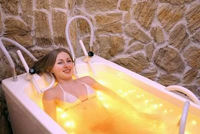 In the early and later recovery period of the disease, a good result is given to therapeutic dirt, sulfide, radon baths. Impose mud applications to the appropriate spinal segments, arms and legs by type «Gloves», «Polukurtka», «Jacket», «socks», «Polinry», «trousers». Therapeutic physical education is carried out 30-60 minutes before or 1-2 hours after mud appliqués. Patients with severe motor disorders mud appliqués, sulphide or radon baths need to alternate with module electrostimulation by modulated currents. Such therapeutic complexes are repeated once every 6 months for 3 years, and in some cases and longer. Each procedure from these therapeutic complexes must be accompanied by a resting period of 40-60 minutes.
In the early and later recovery period of the disease, a good result is given to therapeutic dirt, sulfide, radon baths. Impose mud applications to the appropriate spinal segments, arms and legs by type «Gloves», «Polukurtka», «Jacket», «socks», «Polinry», «trousers». Therapeutic physical education is carried out 30-60 minutes before or 1-2 hours after mud appliqués. Patients with severe motor disorders mud appliqués, sulphide or radon baths need to alternate with module electrostimulation by modulated currents. Such therapeutic complexes are repeated once every 6 months for 3 years, and in some cases and longer. Each procedure from these therapeutic complexes must be accompanied by a resting period of 40-60 minutes.
Very useful treatment on balneological resorts with sulphide, uodobromic, chloride sodium, radon, nitric, siliceous terminal waters, as well as on mud resorts: Lipetsk, Sochi - Matsesta, Sergiev Mineralnye Vody, Evpatoria, Saki, Odessa, and DR.
The duration of the reducing period is different: from several months to 1-2 years. Rarely disease takes a recurrent or chronic character.
The presence of residual phenomena, the recurrent or chronic course of the disease can lead to a decrease or loss of working capacity. Recovery processes, with other things being equal, are more favorable in persons who received full-fledged inpatient treatment in the acute period - repeated courses of rehabilitation therapy.
Thus, most patients undergoing Guillana Barre syndrome, medical and professional rehabilitation effective. However, due to pronounced motor disorders, almost 1/3 patients significantly reduces the ability to work, which may be the basis for determining the disability group. Slow restoration of disturbed functions and rehabilitation dictate the need to dispensarization with repeated treatment courses, depending on the severity of the process: Hospital - Rehabilitation department (or Center) - Sanatorium.
Abrementability examination should take into account the nature of the course of the disease (acute, subacute, chronic, recurrent), the severity of the lesion and severity of phenomena. With a loss or significant reduction in qualifications, the III group of disability is prescribed. In cases of persistent pain syndrome or significant disorders, especially with an unfavorable process, establish II group. With deep palices or paralymps that are often accompanied by a violation of the function of the pelvic organs, the 1st group of disability is usually defined.

